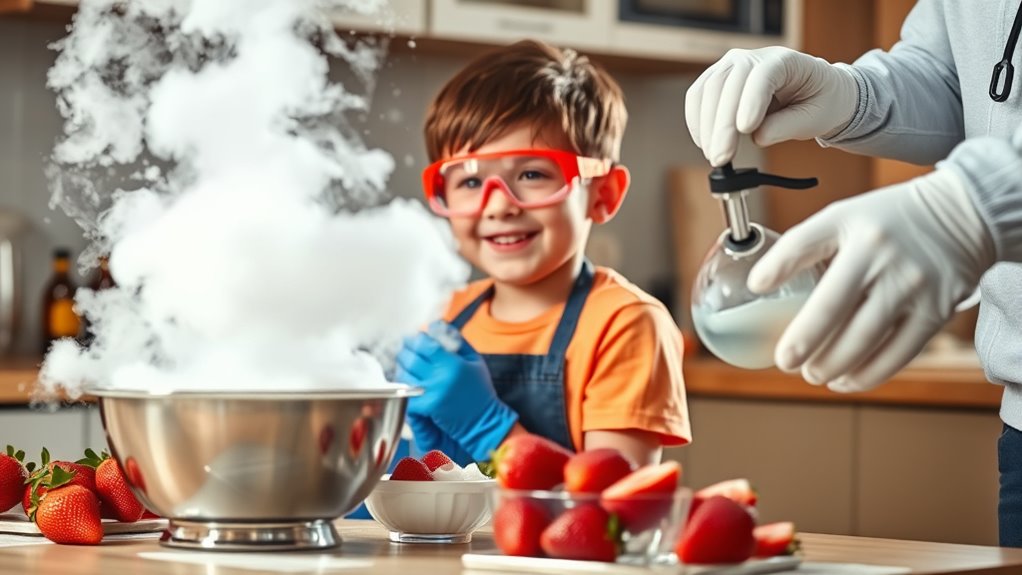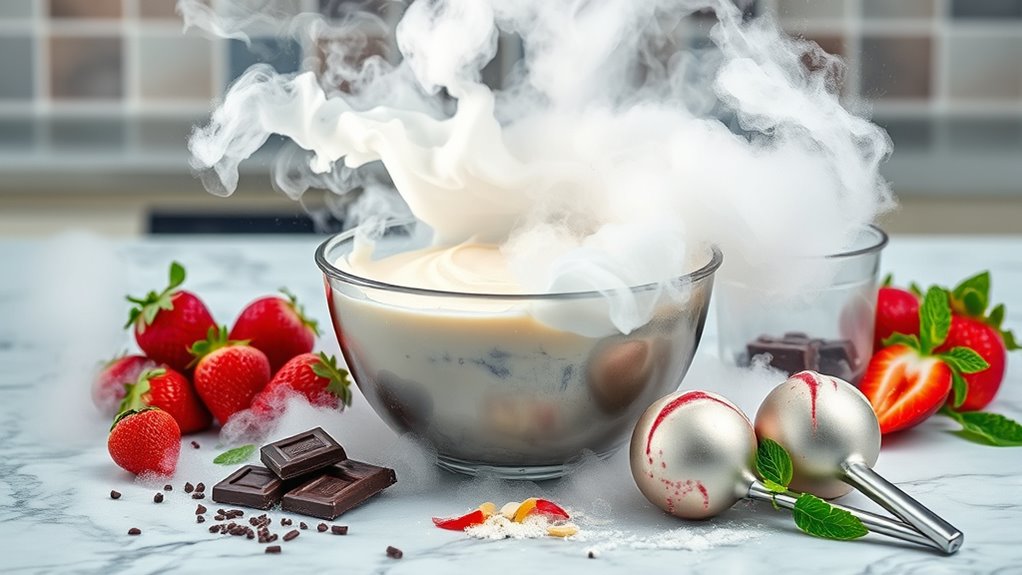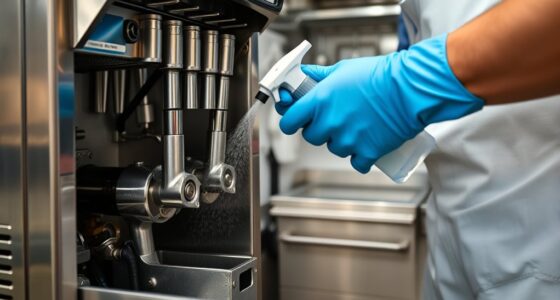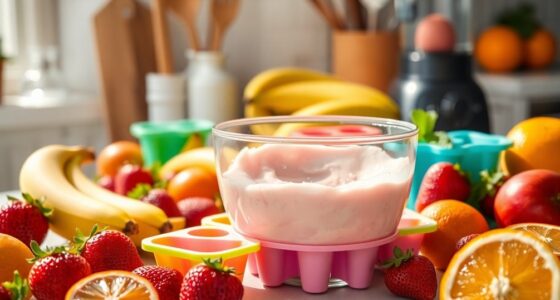Making ice cream with liquid nitrogen is a thrilling experiment you won’t want to miss! Start by mixing heavy cream, milk, sugar, and vanilla in a bowl. While stirring, gradually add liquid nitrogen, watching the mixture freeze instantly into creamy goodness. Remember to wear gloves and goggles for safety. This method locks in flavors and creates a smooth texture. If you’re curious about flavor combinations and the science behind this fun treat, there’s more to explore!
Key Takeaways
- Liquid nitrogen rapidly freezes the ice cream mixture, creating a creamy texture by minimizing ice crystal formation.
- Essential ingredients include heavy cream, whole milk, sugar, vanilla extract, and liquid nitrogen for optimal results.
- Always prioritize safety by wearing gloves and goggles to prevent frostbite and injuries from liquid nitrogen.
- Stir continuously while adding liquid nitrogen to ensure even freezing and flavor distribution throughout the mixture.
- Experiment with unique flavor combinations and mix-ins for fun, unexpected results in your ice cream creations.
Liquid Nitrogen Basics

Liquid nitrogen, at a chilling -320°F (-196°C), is an incredible tool in the kitchen, especially for making ice cream.
Liquid nitrogen, at a frigid -320°F, is a game-changer in the kitchen for making irresistibly creamy ice cream.
This cryogenic liquid, mostly nitrogen from the atmosphere, helps you achieve a creamy texture by rapidly freezing your mixture. Since it’s odorless, colorless, and tasteless, it won’t alter the flavor of your ice cream.
The quick freezing prevents large ice crystals from forming, preserving the creaminess and nutrients better than traditional methods.
To use liquid nitrogen safely, you’ll need specialized containers called Dewars for storage.
Just remember, while it’s a fun experiment, handling it requires caution, so be prepared with gloves and goggles.
Immerse yourself in this innovative technique and enjoy making unique ice cream creations!
Safety First

When working with liquid nitrogen, wearing safety gloves and goggles is a must to protect yourself from severe frostbite and eye injuries.
Since liquid nitrogen is extremely cold, you need to avoid any skin contact to prevent tissue damage.
Always handle it in a well-ventilated area to keep yourself safe from nitrogen gas buildup and potential asphyxiation hazards.
Essential Safety Gear
Safety gear is essential when working with liquid nitrogen, as it helps prevent serious injuries.
Always wear safety gloves and goggles to protect yourself from severe frostbite and eye injuries caused by the extreme cold of -320°F (-196°C).
It’s vital to keep all participants informed about the hazards of liquid nitrogen and the need to avoid skin and face contact.
Be certain to use proper storage containers, like Dewars, to minimize evaporation and enhance safety.
Conduct your ice cream-making process in a well-ventilated area to prevent nitrogen gas accumulation, which can displace oxygen and create asphyxiation risks.
Finally, hold a safety briefing before starting to guarantee everyone understands the protocols and emergency procedures related to liquid nitrogen use.
Handling Liquid Nitrogen
While you may be excited to plunge into making ice cream with liquid nitrogen, it’s crucial to prioritize safety during the process.
Handling liquid nitrogen requires attention to specific safety protocols to avoid serious injuries.
- Always wear insulated gloves and safety goggles to protect against splashes.
- Work in a well-ventilated area to prevent asphyxiation from nitrogen gas.
- Never ingest liquid nitrogen or let it touch your mouth; it can cause severe internal injuries.
- Observe demonstrations by experienced individuals to learn proper techniques.
- Keep a safety kit nearby, including a first-aid kit and emergency contact numbers.
Where to Buy Liquid Nitrogen

Wondering where to buy liquid nitrogen? You can start by searching online or checking local listings in the Yellow Pages.
Many suppliers cater to various industries, so you might find a good source in your area. Farmers, welders, and pediatricians often have leads on where to buy liquid nitrogen, so don’t hesitate to ask around.
When you acquire your liquid nitrogen, it’s crucial to store it in a Dewar, a specialized container designed to minimize evaporation.
Also, consider checking if suppliers offer rental or borrowing options for Dewars.
The Recipe

To whip up your own liquid nitrogen ice cream, you’ll need a few essential ingredients and a simple method.
Start with heavy cream, whole milk, sugar, and vanilla extract, and feel free to add your favorite mix-ins.
Once you have everything ready, I’ll guide you through the step-by-step instructions for creating a delicious treat.
Essential Ingredients Needed
Creating delicious liquid nitrogen ice cream starts with a few essential ingredients. You’ll need to gather the following:
- 2 cups of heavy cream
- 1 cup of whole milk
- 3/4 cup of granulated sugar
- 1 teaspoon of vanilla extract
- Approximately 250 ml of liquid nitrogen
These ingredients will form the base of your ice cream.
To make it perfect, remember to stir the mixture continuously while adding the liquid nitrogen. This rapid freezing process guarantees a creamy texture that’s hard to beat.
You can also add fun extras like chocolate chips, berries, or candy to customize your treat.
Just be certain to let any excess liquid nitrogen evaporate before serving for safety and the best texture!
Step-by-Step Instructions
Follow these simple steps to whip up your own liquid nitrogen ice cream.
Start by whisking together 2 cups of heavy cream, 1 cup of whole milk, 3/4 cup of granulated sugar, and 1 teaspoon of vanilla extract until the sugar dissolves.
Pour this mixture into an ice cream maker and churn it according to the manufacturer’s instructions until it reaches a soft-serve consistency.
Now, gradually add small amounts of liquid nitrogen, about 250 ml, while stirring continuously with a spatula for a creamy texture.
Keep adding liquid nitrogen until the ice cream is fully frozen, stirring consistently to avoid large ice crystals.
This method can create a texture similar to churned perfection with an ice cream maker, making it a fun alternative to traditional methods.
Serve immediately after letting any excess liquid nitrogen evaporate, and enjoy your delicious creation!
The Science Behind the Freeze

While you might think of ice cream as a simple treat, the science behind making it with liquid nitrogen reveals fascinating principles of chemistry and physics at play.
Here’s what you need to know about the rapid freezing process:
- Liquid nitrogen is extremely cold, at -320°F (-196°C), freezing your ice cream mixture almost instantly.
- This quick freezing prevents large ice crystals from forming, ensuring a smoother texture.
- Smaller fat and water particles contribute to a creamier consistency in the final product.
- Gas expansion and contraction show how liquid nitrogen vaporizes, creating a dramatic effect as it freezes.
- Understanding the shift from liquid to solid is key to mastering this method of making ice cream.
Flavor Experimentation

Exploring flavor experimentation with liquid nitrogen ice cream opens up a world of creative possibilities. You can mix traditional flavors with unexpected ingredients, creating unique combinations. For example, try adding chocolate chips, caramel, or even Flamin’ Hot Cheetos mac and cheese powder.
| Base Flavor | Mix-Ins | Unique Twist |
|---|---|---|
| Peanut Butter | Fresh Fruit | Pickles |
| Vanilla | Ramen | Spicy Sriracha |
| Milk Tea | Chocolate Chips | Matcha Powder |
As you pour liquid nitrogen, keep stirring to evenly distribute your ingredients. This quick freezing process locks in flavors, ensuring a creamy texture without ice crystals. It’s all about balancing fun and taste!
Educational Presentations: Science Fun

Creating ice cream with liquid nitrogen isn’t just about flavor experimentation; it’s also a fantastic way to engage students with the science behind the process.
During your educational presentations, you’ll cover essential topics that make science fun:
- The properties of liquid nitrogen and its boiling point of -320°F (-196°C)
- The concept of states of matter and how ice cream making relates to it
- The ideal gas law and its implications in everyday phenomena
- The importance of safety equipment, like gloves and goggles, when handling liquid nitrogen
- The hands-on experience of heat transfer and its effect on ice cream texture
Frequently Asked Questions
How to Make Ice Cream Using Liquid Nitrogen?
To make ice cream using liquid nitrogen, start by combining heavy cream, whole milk, sugar, and vanilla extract in a bowl until the sugar dissolves.
While stirring the mixture, slowly pour in the liquid nitrogen. This rapid freezing method creates a creamy texture without large ice crystals.
Don’t forget to wear gloves and goggles for safety.
You can also add your favorite flavorings or mix-ins to personalize your ice cream!
What Experiments Can You Do With Liquid Nitrogen?
When you investigate the fascinating world of liquid nitrogen, you open a treasure trove of experiments.
You can witness the extraordinary transformation of materials, like inflating a balloon only to watch it shrink dramatically.
Pouring liquid nitrogen over warm water creates enchanting clouds of vapor, illustrating phase changes.
Additionally, you might explore unique textures in food through freeze-drying, revealing delightful flavors and experiences that tantalize your senses.
How Does Liquid Nitrogen Affect Ice Cream?
Liquid nitrogen affects ice cream by rapidly freezing the mixture, which prevents large ice crystals from forming. This results in a smoother texture that you’ll love.
As it freezes, the gas expansion incorporates air, making your ice cream lighter and creamier. Plus, this quick cooling process retains more nutrients, enhancing the flavor.
You’ll notice the small fat and water particles contribute to an irresistible creaminess, elevating your ice cream experience.
What Happens if You Pour Liquid Nitrogen on Dry Ice?
When you pour liquid nitrogen on dry ice, you’ll witness an impressive reaction. The extreme cold causes the dry ice to sublimate rapidly, creating a thick, dense fog of carbon dioxide gas.
You’ll notice the liquid nitrogen boiling vigorously as it interacts with the dry ice, forming bubbles that burst quickly.
However, be cautious; the intense cold can lead to frostbite, and the gas buildup can create pressure in a closed container, posing explosion risks.
Conclusion
Making ice cream with liquid nitrogen isn’t just a fun experiment; it’s a thrilling way to explore science in the kitchen. Imagine hosting a birthday party where kids not only enjoy delicious homemade ice cream but also learn about the states of matter. By watching the liquid nitrogen create a frosty cloud, they grasp concepts of temperature and changes in state. This hands-on experience sparks curiosity and fosters a love for science that can last a lifetime!










